Manuscript accepted on :April 29, 2009
Published online on: 12-11-2015
Plagiarism Check: Yes
T. Chakraborty¹, M. Baidya¹*, A. Chakraborty¹ and M. Baidya²
¹Krupanidhi College of Pharmacy, Chikkabellandur, Carmelram Post, Bangalore- 35 India.
²Kaliayaganj College, Kaliayaganj, Uttar Dinajpur India.
Abstract
Objective A questionnaire-based survey was conducted to know about the prevalence, attitude and knowledge of Paracetamol a self-medicated drug that effectively infected the young student population of age between 14-18 years. Methods The study was conducted on October - November 2008 on questionnaire-based survey in Kharagpur, West Bengal where the people form all over India resides. Total number of volunteers (male and female) was three hundred and ninety four (394) (age between 14 to 18 years). Results The prevalence of self-medication in young student was quite high and that was 66.24%. Among the self-medicated student 47.64% utilize Paracetamol as their first choice of medicine. 72.58% of the same population agreed that the practice of self-medication is dangerous. The most common reasons for self-medication were parental advice (16.61%) although they were highly educated, lack of time (25.78%), Cheap (6.5%), lack of consciousness about the disease (37.82%), reuse of old prescription (2.57%), quick relief (3.43%), and easy availability (2.0%). Conclusion From the above data we can conclude that despite majority being aware of harmful effects of self-medication its prevalence is high in the educated youth. It was observed that almost half of the young population took Paracetamol as the first choice of medication. Although it is considered to be a safe OTC product but on prolong practice it shows hepatotoxicity and other complication, which the youth is unaware off. Hence, there is a need to educate the youth to ensure safe practices. Strict policies need to be implemented on the advertising and selling of OTC medications to prevent this problem from escalating.
Keywords
Self-medication; Paracetamol; Educated youth; OTC
Download this article as:| Copy the following to cite this article: Chakraborty T, Baidya M, Chakraborty A, Baidya M.Paracetamol- A Self Medicated Popular Drug Abuse by Young Student Community. Biomed. Pharmacol. J.2009;2(1) |
| Copy the following to cite this URL: Chakraborty T, Baidya M, Chakraborty A, Baidya M.Paracetamol- A Self Medicated Popular Drug Abuse by Young Student Community. Biomed. Pharmacol. J.2009;2(1). Available from: http://biomedpharmajournal.org/?p=625 |
Introduction
A large number of people, when they fall sick, do not consult the physician. We have noticed that right from popular magazine editors to our domestic servant everyone thinks that he or she is a medical authority, and if we have a fever, cold, cough, constipation or indigestion, our friends or even total strangers volunteer advice on medicines to take like expert physicians. Almost everyone we meet has an excellent remedy for whatever ails we have. In short, this is what is meant be self-medication1. May be most of the times nothing untoward happens on following such advice, but it can be dangerous. Medicines are important to help us get cured at the right time. But popping medicines on our own, without the doctor’s consult can become fatal2.
The present youth will be the backbone of future India. They are carefree never giving a thought for their coming future. They have the ability to learn and acquire knowledge from their surrounding but do not have the intelligence to distinguish between evil and good. Thus the youth is more prone to habits whether good or bad, but they tend to learn bad habits faster then the good ones as they are easy to follow. Among many bad habits one of the dangerous habits is that of self-medication3,4,5.
The present survey was aimed to determine the prevalence, attitude, and knowledge of self-medication of Paracetamol among the adolescent youth and a sustained awareness to the society regarding the risks of self-medication especially paracetamol – an OTC product and its communicability for the future is warranted.
Methodology
Expert pharmacist and chemist developed a well-designed validated questionnaire. The young students aged between 14 – 18 yrs (i.e. from classes IX to XII, irrespective of their sex) of Kharagpur a renowned railway town in West Bengal was selected as study center as people from all over India resides there. The adolescent youth were advised to answer the questionnaire according to their own perception and experience. Three hundred and ninety four young students of schools participated in the survey. Some of our co- investigators assisted us in the overall data collection from the above study center of kharagpur, West Bengal. The collected data was screened and Subjects were divided into two study groups according to their pattern of drug use: self-medication and medical prescription. Self-medicated patients were further sub-divided into patients who took paracetamol as their first choice of medication and the latter, which took some other easily available medicines for the same ailments. The data thus obtained was studied statistically and the inference was made accordingly6,7,8.
Results and Discussions
After the statistical validation of the data collected from the respondents, it indicated that (66.24%), of the youth practiced self-medications although the majority of the same population i.e 72.58% thought that self-medication is not correct. (Table I, Figure I and II)
Table 1: Medication Pattern and opinion of respondents on self-medication
| Number of participants | Medicine taken
|
Opinion regarding Self medication | ||||
| Self medication | Prescribed medication | Not answer | Correct | Not correct | Not answer | |
| 394 | 66.24% | 32.99% | 0.76% | 26.64% | 72.58% | 0.76% |
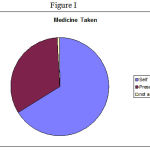 |
Figure 1:
|
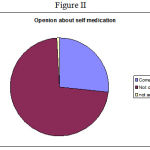 |
Figure 2:
|
Table 2: Reason for self medication.
| Poor patient doctor relationship | Lack of time | Emergencies | Not answer |
| 58.60 | 37.82 | 0.57 | 2.8 |
The young volunteers gained their knowledge of self medication from various source like neighbors, parents, friends, and relative and even by consulting with medical shopkeepers.
The most important factor what we observed is the doctor patient relationship (58.6%), which has become more commercial rather than a novel service.
The main groups of self-prescribed drugs were analgesic/antipyretic (most commonly paracetamol 47.63% and aspirin 15.68%) and other drugs. The table III and Figure IV has explained the various marketed formulation used by same population. The test volunteers used to take paracetamol to cure their various ailments like common cold (25.03%), fever (28.78%), body pain (18.98%), headache(10.30%), running nose(8.52%) and before attack of cold (5.62%) without knowing the proper disease condition, proper use of drug, dose and frequency of administration, side effects and the adverse reaction on their body. Finally they fall prey to the side effects and obtain serious diseases9,10. Table IV and Figure V.
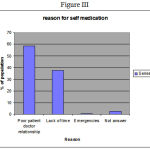 |
Figure 3:
|
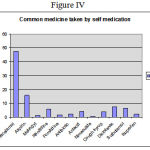 |
Figure 4:
|
Table 3: Different drugs taken.
| Sl No | Name of the drug | % of population used |
| Paracetamol | 47.63 | |
| Aspirin | 15.68 | |
| Metrogyl | 1.18 | |
| Ranitidin | 5.91 | |
| Fomitidin | 1.77 | |
| Antibiotics | 2.07 | |
| Anticid | 4.14 | |
| Nimesulide | 0.59 | |
| Citrizine | 3.84 | |
| Codine Phosphate | 7.39 | |
| Diclofenac | 6.50 | |
| Sulbutamol | 1.18 | |
| Ibuprofen | 2.07 |
Table 4: Reason behind use of Paracetamol
| Common cold | Fever | Body Pain | Headache | Running nose | Before the attack
of cold |
Not
Answer |
| 25.03 | 28.75 | 18.98 | 10.30 | 8.52 | 5.62 | 2.8 |
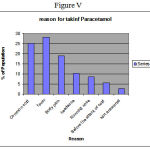 |
Figure 5:
|
Conclusion
The prevalence of self-medication of paracetamol of different brand names in adolescents was high, which reinforces the need for public health interventions aiming at preventing this practice. The community health care pharmacist, pharmacy teachers with school teachers should join hands with other healthcare workers and social workers to communicate the information about the awareness of self medication. It is also recommended to have at least one subject as pharmacy education in their academic syllabus to spread awareness among the youth of today. Mass awareness programmes among the youth with the Financial Assistance from Ministry of Health and Family Welfare, WHO, UNICEF, World Bank, DANIDA can be conducted in schools of rural and urban areas to enlighten the youth community about the dreadful disease of self- medication. If these measures are employed vigorously the practice of self-medication can be uprooted from its base.
Acknowledgement
The authors acknowledge Prof Dr Suresh Nagpal, Chairman, krupanidhi Institutions, and Prof Dr Amit Kumar Das, Principal, Krupanidhi College of Pharmacy, for providing necessary facilities to carry out the survey in an effective manner. We also thank the principals of St. Agnes School, S.E Railway Mixed Higher Secondary School, kendriya vidyalaya II, kharagpur, West Bengal for providing their students as our participants.
Reference
- Balbuena FR, Aranda AB, Figueras A. Self-medication in older urban mexicans: an observational, descriptive, cross-sectional study. Drugs Aging 2009;26(1):51-60.
- Närhi U.Sources of medicine information and their reliability evaluated by medicine users. Pharm World Sci. 2007 Dec;29(6):688-94.
- Zafar SN, Syed R, Waqar S, Zubairi AJ, Vaqar T, Shaikh M, et.al. Self-medication amongst university students of Karachi: prevalence, knowledge and attitudes. J Pak Med Assoc. 2008 Apr;58(4):214-7.
- Sawair FA, Baqain ZH, Abu Karaky A, Abu Eid R. Assessment of self-medication of antibiotics in a Jordanian population. Med Princ Pract. 2009;18(1):21-5.
- Sawalha AF.A descriptive study of self-medication practices among Palestinian medical and nonmedical university students. Res Social Adm Pharm. 2008 Jun;4(2):164-72.
- Awad A, Al-Rabiy S, Abahussain ESelf-medication practices among diabetic patients in Kuwait. Med Princ Pract. 2008;17(4):315-20.
- De Bolle L, Mehuys E, Adriaens E, Remon JP, Van Bortel L, Christiaens T.Home medication cabinets and self-medication: a source of potential health threats? Ann Pharmacother. 2008 Apr;42(4):572-9.
- Al-Azzam SI, Al-Husein BA, Alzoubi F, Masadeh MM, Al-Horani MA. Self-medication with antibiotics in Jordanian population.Int J Occup Med Environ Health. 2007;20(4):373-80.
- Westerlund M, Brånstad JO, Westerlund T.Medicine-taking behaviour and drug-related problems in adolescents of a Swedish high school. Pharm World Sci. 2008 Jun;30(3):243-50.
- Pereira FS, Bucaretchi F, Stephan C, Cordeiro RSelf-medication in children and adolescents. J Pediatr (Rio J). 2007 Sep-Oct;83(5):453-8.







